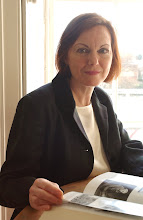 I’ve just received a fascinating e.mail from Raymond Foster whose ancestors, the Newsoms of Bloomsbury Square, were featured in February. Raymond writes: ‘… as a result of researching Jane Hovil Newsom's father, John Sawyer I happened upon some material about an Elizabeth Sawyer who resided at 35 Montague Place (Bloomsbury) in 1861 and who I thought might have been a relative. The Census for that year describes her as a widow aged 34 years, born in Tenterden, Kent, and records a range of young children and a retinue of servants and also a visitor, described as an uncle, L.H. Sawyer, aged in his late 50s and normally resident in Dublin.
I’ve just received a fascinating e.mail from Raymond Foster whose ancestors, the Newsoms of Bloomsbury Square, were featured in February. Raymond writes: ‘… as a result of researching Jane Hovil Newsom's father, John Sawyer I happened upon some material about an Elizabeth Sawyer who resided at 35 Montague Place (Bloomsbury) in 1861 and who I thought might have been a relative. The Census for that year describes her as a widow aged 34 years, born in Tenterden, Kent, and records a range of young children and a retinue of servants and also a visitor, described as an uncle, L.H. Sawyer, aged in his late 50s and normally resident in Dublin.Nothing particularly noteworthy about that and I can't establish any definite link with Jane Hovil Newsom (nee Sawyer) living just round the corner in Bloomsbury Square (and later by the way in Southampton Row). What caused me some surprise though was that 10 years later, in 1871 there is (another?) Elizabeth Sawyer recorded at exactly the same address - 35 Montague Place - but this one is aged 40, born in Brighton and described as an annuitant. There were no children present, just one servant and an Irish Peer, Viscount Frankfort - Lodge Raymond de Montmorency, 2nd Viscount Frankfort de Montmorency to give him his full title. I did a little research on the 2nd Viscount, born in 1806, and discovered that apart from being an Old Etonian and guardsman, he was in 1861 on trial in London for publishing an indecent communication (reported in "Victorian London" by Liza Picard). He apparently served a year's imprisonment with hard labour in Pentonville but was able to avoid the hard labour component of his sentence by paying towards his keep in prison. I also read that there was a strong suggestion that he was in fact insane, and at least one instance of assault - by spitting on someone in the street - was evinced in support of this. I'm sure there must be more material available about this intriguing character. I don't know if this is at all relevant to the "Bloomsbury People" project but it might add a little extra flavour. It hasn't added anything definite to my own family research but it did provide some entertainment! Incidentally I am fairly sure that the Frankfort line is now extinct! Best wishes, Raymond Foster (no relation to the 2nd Viscount as far as I know).’
The Frankfort de Montmorencys were Irish peers, owning thousands of acres in Carlow, Cavan and Kilkenny. They were, nevertheless, absentee landords and the agent who managed the 2nd Viscount’s estates described him in 1843 as ‘becoming as oblivious in Matters of business as he is insane in other Matters’ (page 2 of online document). This was the time of the devastating Irish famine and the Viscount was said to be ignorant of the extent of distress (as many absentee landlords were). In 1842, he was living in Paddingon, west London, when Alice Lowe was tried at the Old Bailey for stealing property from his house. The Viscount’s testimony is garbled to say the least and it turned out that Alice Lowe had been living with him for several weeks prior to the ‘theft’. A pawbroker who gave evidence maintained that she had been a regular customer for four years and intimated that she regularly co-habited with ‘noblemen’ and pawned their valuables. Alice was found not guilty.
In 1843, the Viscount sent a notice to every member of the House of Lords complaining of ‘grievances and injuries, which for several years have seriously interfered with, and in some instances fatally destroyed his domestic arrangements, placed him at variance with his family connections …’ etc. Four years later he appeared at the Middlesex Sessions on a charge of assault (the spitting episode mentioned by Raymond), and then in 1852 he was tried at Bow Street Magistrates Court for defamation and libel after circulating letters supposedly from members of the aristocracy. In fact, the content of the letters suggest that the Viscount was seriously deluded. He mentions a ‘secret committee’ tampering with intimate friends, turning the inabitants of the country into cannibals and taking children of rank out of their graves, etc. etc. The Liverpool Standard, commenting on this case, observed: ‘That [the Viscount] is a fit subject for a lunatic asylum can hardly be doubted; but that his disease of mind has been induced by depraved habits is abundantly obvious.’ Full details of these events are online (scroll down to end of document).
The photograph above (xynt4x Flickr) shows Montague Square with the back of the British Museum on the left and the offices of Senate House, University of London on the right.
